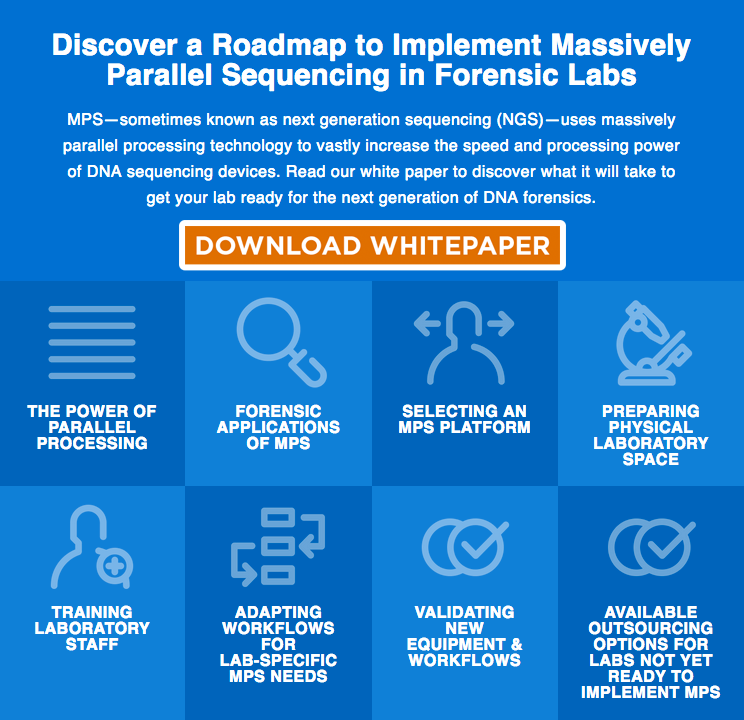Massively Parallel Sequencing (MPS) is now a mainstream technology in many academic areas, and has led to revolutionary discoveries in medicine, biology and environmental science. But most forensic laboratories are not yet ready to implement the technology. What can be done to accelerate adoption and bring the advantages of MPS to the forensic community?
Submitted by: Battelle
For the past year, Battelle and the Ohio Bureau of Criminal Investigation (Ohio BCI) have been working together to implement MPS in an Ohio BCI lab. The project builds on five years of work by Battelle for the Department of Defense (DoD) and National Institute of Justice (NIJ). The lessons learned have now been translated into an implementation roadmap for forensic labs wishing to get up and running with MPS.
The Power of MPS for Forensic Identification
MPS (sometimes known as Next Generation Sequencing, or NGS) uses massively parallel processing to increase the speed and processing power of DNA sequencing. In essence, this means that MPS devices can process millions of reads (sequences of nucleotides) per run. This gives MPS vastly more resolution than CE sequencing technologies.
That resolution is of critical importance when it comes to some of the most difficult cases in forensic science, including identification of human remains. With MPS, a single sequencing run may generate data that encompasses a wide range of genetic markers, such as short tandem repeats (STRs), single nucleotide polymorphisms (SNPs) and even mitochondrial DNA (mtDNA). This can provide a significant advantage when dealing with samples of limited quality, including highly degraded samples and complex mixed samples.
MPS provides another crucial advantage over CE sequencing: it allows forensic labs to extract meaningful information from samples even when database searches do not confirm a match. This can include statistical predictions for ancestry and geographic origin, potential familial relationships and even certain physical characteristics (phenotypes) such as hair and eye color, skin tone and some facial characteristics. This ability may prove to be of critical significance in providing clues for identification of unknown human remains.
Developing a Roadmap to MPS Implementation
These advantages prompted Ohio BCI to implement in-house MPS capabilities in their forensic laboratories in order to speed up investigation of missing person cases. The agency had been outsourcing sample processing for highly degraded samples to an academic lab, a process that often took months. Implementing MPS in house will allow them to dramatically speed up analysis time for missing persons investigations. It could also provide new leads for cold cases.
However, getting there requires changes in instrumentation, workflow, quality control, validation and training. For the past year, Battelle and Ohio BCI have worked together to implement MPS in an Ohio BCI lab and conduct a joint validation study on the technology and workflows. Together, Battelle and Ohio BCI have developed an implementation roadmap to guide implementation for other forensic laboratories, which includes:
- Selecting an MPS Platform
- Preparing your physical laboratory space
- Training of laboratory staff
- Adapting workflows for your lab’s specific MPS needs
- Validation of new equipment and workflows
To read more about implementation considerations for MPS in forensic laboratories, download the full report:
The Ohio BCI project builds on Battelle’s prior work DoD and NIJ. The Battelle Applied Genomics team led a five-year project to implement MPS technology in the field for the DoD. In 2015, Battelle was chosen to lead an NIJ project evaluating NGS methods in forensic labs around the country. The 19-month study evaluated available MPS technologies and workflows in seven labs across the country. Battelle also designed a testing matrix to assess the performance of each MPS workflow and address key validation elements of the DNA Quality Assurance Standards including concordance, reproducibility, sensitivity, mixtures and accuracy.
Getting There from Here
Moving MPS into the mainstream for forensic application will require dedicated effort from forensic laboratories. In the meantime, using a third party for training and validation remains an option. Battelle provides service options for forensic DNA analysis using massively parallel DNA sequencing.
For labs that are ready to move forward with MPS implementation, Battelle offers turnkey technology transfer and implementation services, including education and training, method development and validation, and analytic software.
WOULD YOU LIKE TO SEE MORE ARTICLES LIKE THIS? SUBSCRIBE TO THE ISHI BLOG BELOW!
SUBSCRIBE NOW!


